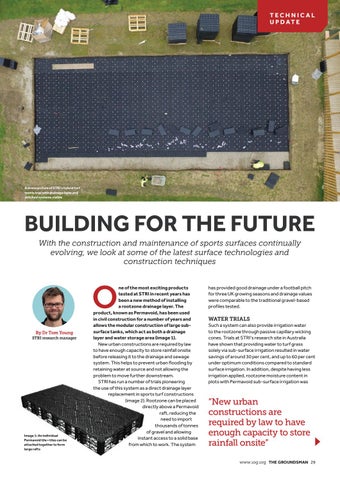TECHNICAL U P D AT E
A drone picture of STRI’s hybrid turf tennis trial with drainage layer and stitched systems visible
BUILDING FOR THE FUTURE With the construction and maintenance of sports surfaces continually evolving, we look at some of the latest surface technologies and construction techniques
O By Dr Tom Young STRI research manager
Image 1: An individual Permavoid tile – tiles can be attached together to form large rafts
ne of the most exciting products tested at STRI in recent years has been a new method of installing a rootzone drainage layer. The product, known as Permavoid, has been used in civil construction for a number of years and allows the modular construction of large subsurface tanks, which act as both a drainage layer and water storage area (image 1). New urban constructions are required by law to have enough capacity to store rainfall onsite before releasing it to the drainage and sewage system. This helps to prevent urban flooding by retaining water at source and not allowing the problem to move further downstream. STRI has run a number of trials pioneering the use of this system as a direct drainage layer replacement in sports turf constructions (image 2). Rootzone can be placed directly above a Permavoid raft, reducing the need to import thousands of tonnes of gravel and allowing instant access to a solid base from which to work. The system
has provided good drainage under a football pitch for three UK growing seasons and drainage values were comparable to the traditional gravel-based profiles tested.
WATER TRIALS
Such a system can also provide irrigation water to the rootzone through passive capillary wicking cones. Trials at STRI’s research site in Australia have shown that providing water to turf grass solely via sub-surface irrigation resulted in water savings of around 30 per cent, and up to 60 per cent under optimum conditions compared to standard surface irrigation. In addition, despite having less irrigation applied, rootzone moisture content in plots with Permavoid sub-surface irrigation was
“New urban constructions are required by law to have enough capacity to store rainfall onsite” www.iog.org THE GROUNDSMAN 29
